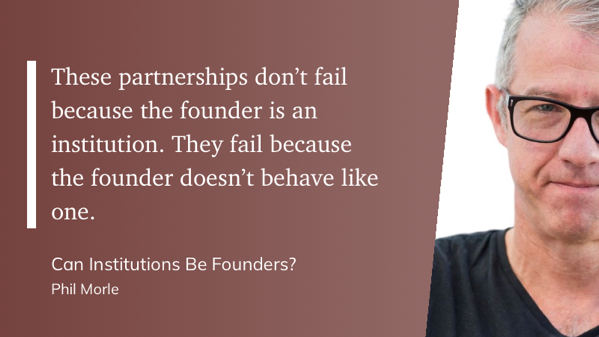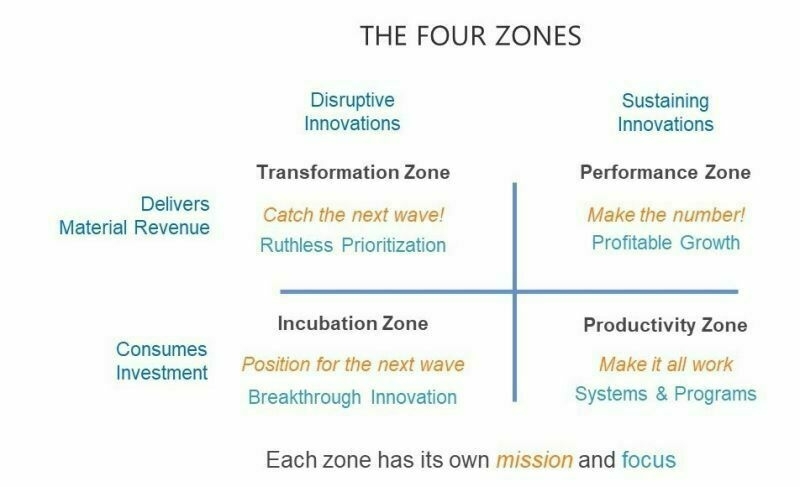Context
Over on LinkedIN, a friend of mine shared a post by Phil Morle 🔗 on whether institutions / corporates can be founders. I wrote a long reply which caused LinkedIN to barf and reject my reply, which in turn caused me to publish two separate pieces; 🖇️ Don’t Trust The Silos. and 🖇️ Friends Don’t Let Friends Use Silos To Publish Their Thinking., neither of which are pertinent to understanding the flow of this ‘reply’, but I wanted to highlight why this isn’t a reply on the post.
In Summary
I asked ChatGPT to summarize the post. 🖇️ In 200 characters AND 200 words … not by usual gorgeous style 🤣 - but not wrong.
My Reply
The piece was good and I wanted to add my two cents, since on initial read I found it confusing. My interpretation of the core premise is to better understand some of the reasons behind why large organizations often fail to ‘innovate’, where ‘tiny companies’ succeed.
The confusion I had started in the title of the piece, ‘Can Institutions Be Founders’ … which extended into the piece itself.
Confused because IMHO, founders are people and whether an organization is big or small, new or old, innovative or staid … they are not people, though they are made up of people … and processes, strategies, plans …

… yes … AND … the organization doesn’t allow the founder to behave like one.
PayPal, to randomly choose an innovative start up, was an organization with a large number of subsequently famous founders that went on to start many other successful innovative companies that changed the landscape of business. The founders were/are people. It is people that are the innovators. The startups, the organizations are the vehicles that enable that change.
One of the great unspoken truths of the start up world is that despite our worship of the individual, we ignore that they don’t do it by themselves. They have an idea and build a company made up of many people to realize their vision. The team all contribute to the organizations success. Don’t look to me to document the traits of a great ‘founder’, plenty of places to check that list, just to say that an organization can allow those traits to soar and create … or they can kill it.
Jobs, Gates, Ellison … insert your ‘hero of choice’ … are great at what they do/did because of their original vision, their leadership, their focus, their tenacity, their communications, their sales ability and so much more … but none of them succeeded without their team to realize their ambition.
In other words .. it is the Organisation that delivers the vision.
So the real question is why does it more often than not, take an organization called a startup to deliver those transformative innovations rather than an existing organization? (Yes - there are exceptions.) Remember Gates and Ellison seperately out innovated IBM, Jobs, Xerox, FinTech startups are leaving Banks and Financial Institutions in the dust, Bezos destroyed the bookstores … it’s an epidemic .. but we associate the founders name with the innovation and success .. and forget that without the team of people they assembled they could never execute.
With that caveat out of the way, arguably Ellison could have joined IBM and … with an instant team, and finance ‘ready to go’ would likely have failed. Bezos could have joined Barnes and Noble … and failed, the Collison brothers could have joined Citi .. and failed, Jobs … you get the picture.
They would have failed, not because they didn’t have what it takes, because clearly they do, but rather because because the organization would have clipped their wings.
Why?
The topic has been very well studied and reported on in a book called 🔗 Zone To Win by 🔗 Geoffrey Moore possibly more famous for 🔗 Crossing The Chasm
In the pages of ‘Zone To Win’ you will find a pretty solid analysis of why established organizations fail to innovate. Turns out the first job is to identify what kind of innovation we are talking about …

… and build from there.
(Interesting to note that when we talk about ‘innovation’ our minds automatically jumps to what Geoff describes as ‘disruptive innovation’ on the left in the diagram, but there are also ‘sustaining innovations’, which tend to operate inside those large organizations.)
Meanwhile, the founders build their organizations in their own image, make their own rules, and relentlessly drive their vision over years … sometimes to the frustration of people inside this companies who have their own ideas as to what could happen. For example both Marc Benioff and Tom Siebel are Oracle alumni that had the vision of ‘software for sales’ respectively (not respectfully) creating Salesforce and Siebel. A vision that at the time was not shared by Larry, so they left. Subsequently LJE became a believer having been an early investor in Salesforce, launching NetSuite and eventually buying Siebel.
In the end, I don’t believe that Phil and I are that far apart in thinking. His summary of the seven people traits are not wrong … but hand in hand with that goes the need for the organization to not just support the fledgling initiative but to actively defend it from the cuckoos who inhabit the rest of the organization.
.. and a framework to unpack the challenge and work out what an organization can do about it.
If there is interest I can expand a lot further, but for now, if you have got this far, THANKYOU. What do you think?
Please throw in your two cents below and let’s see if together we can make a buck.